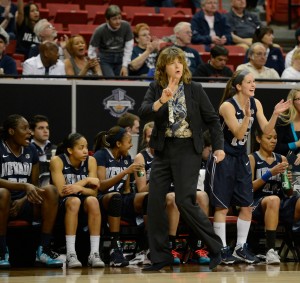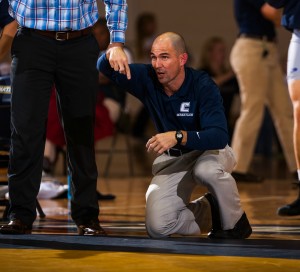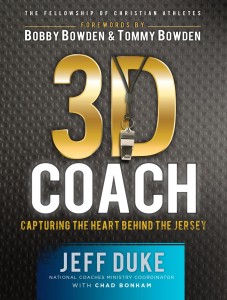This story appears in FCA Magazine’s September/October 2014 issue. Subscribe today!
"One coach will impact more young people in one year than the average person does in a lifetime.”
Billy Graham’s quote resonates with the great and daunting responsibility placed on the shoulders of coaches around the world. It is a call for coaches to unify in one purpose, recognize their platform, and nurture the well-being and growth of their athletes with wisdom and truth. It calls for a new method, or maybe a tried-and-true method of coaching that revitalizes all aspects of the athlete: body, mind and soul.
Through various channels in FCA, the 3 Dimensional Coaching concept acts as a catalyst to develop coaches into who they’re meant to be. Three-dimensional coaching tackles the inner spheres of a coach’s mentality, emphasizing equal importance of mind and heart with physical body conditioning.
“We’re called to go out into this world and make a difference,” said Jeff Duke, FCA National Coaches Trainer and author of 3D Coach: Capturing the Heart Behind the Jersey. “Sports have become so iconic; it becomes a great place to teach life lessons. The question is, what lessons are being taught?”
Most coaches have no trouble emphasizing the first part of the 3D model. They’re competent enough to adequately train an athlete’s body with drills, conditioning and repetition. It’s the second and third parts where many can fall short. Dan Bishop, FCA’s National Director of Training, said research indicated that 85 percent of coaches only coach in the first dimension. Just 15 percent have a strategy for the mind, and a mere 5 percent are focusing on all three.
“At the [mention of] a second dimension, coaches are starting to lean in,” Bishop said. “They’re taking pictures of slides and saying, ‘I need more of this.’”

"Three-dimensional coaching is having a really high standard and saying these are the ways I’m going to treat my players like Jesus treated people."
-Jane Albright, University of Nevada, Reno
Duke added, “Coaches have strategy in the first dimension. They know how to block and tackle and get stronger. But where they’re stuck is those implementation strategies of the second dimension, which leads to the third dimension—your own personal journey as a coach.”
An estimated 60 million kids in the United States are involved in athletics, and the most influential person in that realm is the coach. The three-dimensional coaching method ministers to and through the coach, filling them so their passion overflows into their athletes. Bishop said a coach’s world is “probably at its most intense point ever in history,” and that means more resources—like the 3D coaching model—are needed.
“It’s a methodology, it’s a framework, and it’s a training for coaches that makes an immediate difference and impact for them,” he said.
Duke is no stranger to strategy. With more than 35 years of coaching and sports administration experience, he’s witnessed both hands-on and hands-off coaches. He observed coaching great Bobby Bowden while on staff at Florida State, and he administered his own implementations as a college and high school coach.
Through his journey, Duke said the questions that kept coming up were: “What’s the more meaningful connection to coaching and this relationship with Christ?” “What would it actually look like to coach with Biblical principles that make sense?”
He continued asking those questions as he went back to Florida State for his doctorate of education in sports administration, physical education and recreation, and activated his coaching education curriculum at the University of Central Florida, where he now lectures.
After completing his doctorate, he was asked to develop the Coaching Methods class at UCF, and naturally the foundations of 3 Dimensional Coaching were born.
“As I studied current practice coaching methods, I realized that truth to-day—research—matches exactly how Jesus coached His team,” Duke said. “I am still in awe. If research is truth and Jesus states He is the truth, then both must be the same. It makes the personal of a personal relationship with Jesus very relevant in the life of a coach.”
The impact of coaches continues to be a topic brimming with sought-after methods and social standards, though true effectiveness might not always be immediate.
University of Nevada women’s basketball coach Jane Albright has implemented the techniques into her coaching style and credits an encounter with John Wooden years ago with helping to shape her career early on.
“When I went to go see John Wooden the first time, I asked him how I would know if I’m a good coach,” she said. “He said I wouldn’t know for about 20 years. I had to think about that a lot, but I really bought into that and began to explore through my faith what that looks like to coach with kingdom principles.
“I think the whole three-dimensional concept is an exceptional curriculum that can help people understand what it actually looks like to be involved in coaching.”
Certified FCA staff presenters attend in-services organized by schools and clubs to give an overview presentation of the three-dimensional coaching concept. They discuss the first dimension and preview the next two, drawing coaches in to the concept that transforms from the inside out.
“What our presenters are really equipped to do is go out and make a compelling case for coaches to want to explore this concept deeper,” said Wes Simmons, Northwest Missouri FCA area director and certified presenter.
Coming out of the workshop, FCA staff hope coaches form a transformational purpose statement in writing that will allow them to shift their priorities, dig deeper into their own faith and redefine the way they approach their athletes. The goal, Simmons said, is to get coaches to think through a strategy to coach on all three levels so their primary purpose of being a coach—to change lives—can be realized.

"3D Coaching is not simply another philosophy of coaching. It is a paradigm shift in purpose that leads to the outcomes we all desire, but often fail to achieve."
-Heath Eslinger, University of Tennessee at Chattanooga
That kind of internal transformation is integral for effectively building trust with athletes.
“As you become more and more in line with Christ in your own personal life—first as a Christian, then as a disciple—you see how it changes how you coach,” Duke said. “Those are the same things Jesus taught. That teaching’s been around for a long time; it hasn’t changed. It’s just now what we’re able to do is bring the relevancy of that teaching into the coaching culture.”
For coaches unsure of how to incorporate time for the second and third dimensions (mind and soul), Heath Eslinger had some useful tips. First, the head wrestling coach at the University of Tennessee at Chattanooga said, all it takes is a bit of rearranging. For example: starting practice every day with 20 minutes of journaling, where the athletes log how they feel about themselves or what’s going on in their family lives. Or taking 10 to 15 minutes to do “spot-lighting,” where one member of the team is selected and each of their teammates speaks something of value into their life.
“You want to talk about a kid’s self-confidence going up,” Eslinger said. “When all of a sudden he knows there are people around him who see the value in him, he may not have heard that his whole life.”
Today, many young athletes have a sense of entitlement or confusion while others are coming from brokenness. They’ve buried their hearts behind a wall of arrogance or a lack of motivation, and old methods of reaching them just don’t work as well as they might have in the past.
“Kids want three things,” Eslinger said. “They want someone to believe in them, they want a belief system, and they want a place to belong. We have to give them a reason to care. You’re dealing with kids where one or maybe both parents have walked out. If they can’t trust the two most important people in their life, why should they trust their coach? We have to build that bridge so they can have faith and trust in their coach.”

"One coach will impact more young people in one year than the average person does in a lifetime.” -Billy Graham
Duke added to Eslinger's message.
“When the light bulb goes on that what I do is also my mission field, everything changes," he said. “The coach now has a purpose on and off the field. When that light goes on, the four Cs model explodes, because now the coach gets so excited they want to take their kids to camp, they want them to see, not just hear, the Gospel in action, and they want them to be a part of a Huddle.”
Simmons noted the paradigm shift in mentality: pouring into coaches, fueling an outlet for their purpose.
“Where we sow, we reap,” he said. “As we invest in coaches, it always gives back. They want to make a difference in the lives of kids for Christ.”
Mark Hull, Wisconsin FCA area representative and certified presenter, echoed Simmons in his stance on coaches as vessels to piece together the brokenness in athletics. The whole world is enamored with sports and winning instead of the joy and wonder that sports can bring to people’s lives. The 3D concept does its best to bring a wholeness to fill that void.
“What I’m looking for right now are pockets of beauty that represent the Kingdom,” Hull said. “Pockets of beauty that will take our breath away because that’s what it ought to look like.”
Simmons added that a coach's heart is the target.
“We are here to invest in them and what they are doing," he said. "As God births a vision in their own heart, the overflow of campus, camp and community ministry will be the natural progression after we have first invested in them.”
From that overflow, entire teams and communities can be poured into and challenged to redefine the way they present themselves.

Capture the heart behind the jersey- FCA's newest resource, 3D Coach by Jeff Duke, available at fcagear.com.
"FCA is excited about increasing the impact of the coaches ministry in 2014-15,” said Jeff Martin, FCA's Executive VP of Ministry Programs and Resources. “We believe the entire culture of sport will be shaken for Christ through a vast number of coaches being transformational in their personal and professional lives. We are poised to see a great movement of God through coaches around the world for such a time as this.”
Albright considers investment of time and energy into athletes as a direction of focus for full athletic growth.
“That’s really what three-dimensional coaching is,” she said. “Having a really high standard and saying these are the ways I’m going to treat my players like Jesus treated people. When sports are done right and done with good values, there’s nothing better.”
Photos courtesy of NCAA Photos and UTC Athletics
--This article appears in the September/October 2014 issue of FCA Magazine. To view the issue in its entirety digitally, click here: Sept/Oct 2014 Digital
–Want FCA Magazine in your home or business? Subscribe here: fca.org/orderthemag
–For daily faith and sports content follow @FCAMag on Twitter (www.twitter.com/fcamag) and “Like” FCA Magazine on Facebook (www.facebook.com/fcamag).